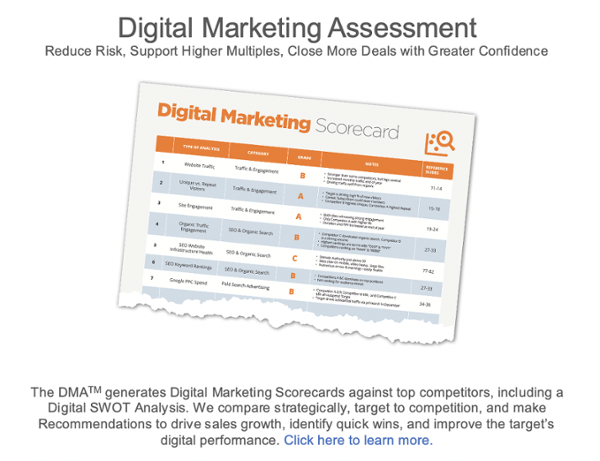
Don’t Delay Your Digital Diagnosis
For B2B companies, COVID-19 has only accelerated the trends towards online sales, which means it’s time to perform a comprehensive review of their digital strategy, and that includes taking a good, hard look at what the competition is doing.
Last year, McKinsey & Co. published a survey on B2B buyer preference, reporting that every phase of the buyer’s journey is migrating online, and in particular, self-service options. In the research phase alone, over the last three years, there was an 85% jump in preference to conduct it online. That might not be so shocking, but during that same time, buyers preference for online resources for the evaluation phase leapt by 238%.
So while historically B2B enterprises have lagged traditional retail in the shift online, it’s catching up. And COVID-19 obviously only sped up that transition, by cancelling the trade shows and network events that were long the mainstay for B2B sales strategy. The implications are enormous, as today’s businesses have to make sure they’re competing with the right message and details online, even before a salesperson gets a customer on the phone.
Since the playing field has moved online, every B2B company needs to review how they serve their market digitally, and that involves looking at web traffic, SEO, digital advertising, social media, web structure and naturally, web content, for both themselves and their competitors. Buyers are now looking for Amazon-grade experiences from their B2B interactions, and won’t accept anything less. And don’t forget, there’s a new generation of buyers in the market, and Millennials avoid phone calls like they’re germs, no matter who’s calling.
The 3 keys to a successful digital strategy
For those that take this trend seriously, the upside can be enormous. That McKinsey survey found that suppliers who provide outstanding digital experiences to their buyers are more than twice as likely to be chosen as a primary supplier than those who provide poor experiences. And “getting it right” means delivering on the three things buyers value most: speed, transparency, and expertise.
Consider this stat from the survey: 33% of respondents rated the option of live chat during the research stage of their buying journey as one of the top-three requirements for a best-in-class supplier. Live chat delivers those three keys: speed, transparency, and expertise. But beyond that, any digital strategy that aspires to encourage customer loyalty needs to, at a minimum, address their most pressing online frustrations.
When survey respondents were asked to share their top-three most frustrating issues with suppliers’ websites:
- 36 percent cited the length of the ordering process,
- 34 percent the difficulty of finding products, and
- 33 percent technical glitches with ordering.
Other common concerns were confusing websites, a lack of information on delivery, unsatisfying technical support, and difficulty setting up payments. But just mull over that first stat: they think online ordering is taking too long. That should be a wake-up call to anyone aspiring to meet today’s expectations.
Next stop: The digital audit
This means that every B2B company needs to invest the time and resources for a comprehensive review of its digital strategy, and the strategy of its competitors. This involves examining every major element of that strategy, as shown in the checklist provided.* However, there is a trap waiting for businesses that race through to check off each point on the list.
Let’s look at the first item: web traffic. If a company examines their own traffic, they might find it boasts 2,000 visitors a month, with a growth rate of 10% every month. Stats like that might prompt a victory lap, but… what if the company’s biggest competitor has 100,000 discrete visitors a month, with a 40% growth rate every month? Suddenly, those stats are an alarm bell, alerting the company how much they have to up their game.
Audit the competition
Too many people tend to do their digital assessments using Google Analytics, but they only study themselves, in isolation of what’s taking place in the market. Review every item on that checklist for every major competitor. It’s not about just grabbing the numbers of their web traffic, but investigating where that traffic is coming from. Is it from social media? And if so, what kind of social media presence does the company have at the moment? Some B2B enterprises don’t have any at all.
Or take a look at their web content. How are they positioning their products? Are they using the same taglines? Are they relaying the value prop? Are they differentiated? Are they employing the best conversion practices? There is so much intelligence available on their peers, it’s almost malpractice to ignore it.
So once every item on checklist is reviewed in terms of the company and its competitors, the next step is to develop recs for how to improve them, and make the appropriate changes. It’s important that anyone conducting the review understands how to translate the findings into a concrete action plan. We pride ourselves on providing a web audit that delivers just that for a reasonable price.
The 70% rule
The rigor of this approach is all built around a goal that isn’t merely about winning impressive web stats. To put it simply, what good are a million visitors to a site, if no one actually buys what the company is selling? This whole endeavor is about improving a company’s digital strategy, which should be dedicated to improving the proposal win rate.
It’s very easy for a customer to stop at the company’s website and request a proposal, but how many of those proposals result in a sale? And we feel that win rate would be around 70%.
When working with managed services provider, we discovered their proposal win rate hovered around 38%. We suggested an independent review of the last ten proposals, no matter if they were successful or not, to discern what factors contributed to the final outcome. And doing that win and loss analysis could drive the win rate up by 15% which in and of itself, would mean a 30% top line revenue opportunity. That’s the power of getting this part of the process right.
The end of the sales “pitch”
Now, the nature of this shift online means that sales staff are getting involved later and later in the sales process, so a really good sales person has to figure out to how to build relevancy and rapport quickly. This can be particularly difficult and requires a balance, since a complex proposal is hard for a salesperson to make over Zoom, but emailing that proposal and chasing the customer down to follow-up can be time intensive and ineffective.
The magic word here is dialogue. Once the digital strategy is compelling enough to reach the proposal stage, it’s time for the salesperson to be mindful to let the customer help shape that proposal. Garner as much feedback as possible, so that the proposal is tailored specifically to their concerns and priorities.
And the best way to build the rapport necessary for that invaluable back and forth is to have the salesperson do their digital audit of the customer, to better understand what matters most in the buying decision. It leads to higher quality questions and a richer conversation with a potential buyer. And most importantly, it demonstrates that the salesperson is listening, which in an attention economy, with so many people shouting online at once, can feel like a breath of fresh air.
Finally, plenty of B2B companies might be quite pleased with their growth, and feel that a digital audit might be unnecessary, but do people only check their blood pressure after a stroke? Patients get annual physicals to discover a problem before it becomes a crisis. And rest assured, even if one’s company is skipping their digital audit this year, the competition certainly isn’t.
Topics: Digital Marketing, Private Equity
Feb 2, 2021 4:38:33 PMFeatured Chief Outsider
/cmo-Karen-Hayward.jpg?width=200&height=200&name=cmo-Karen-Hayward.jpg)
.png?width=1500&height=398&name=CO_Corporate%20Logo%202021_4C_HOR_FNL-1%20(1).png)


